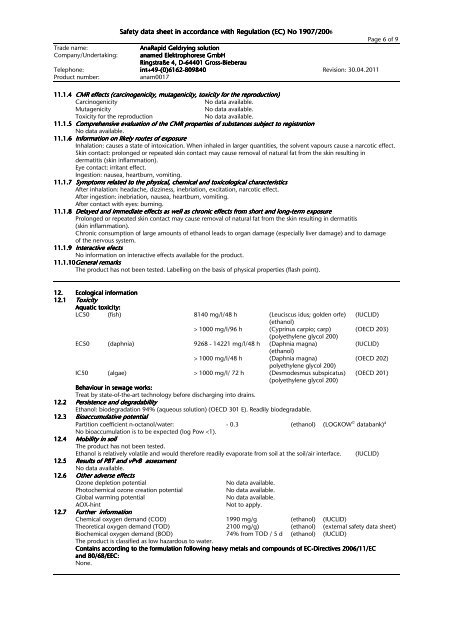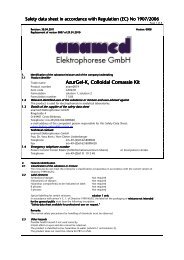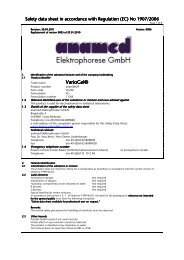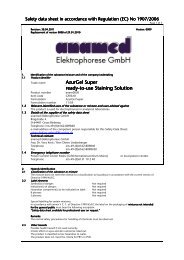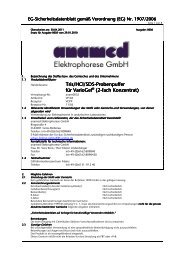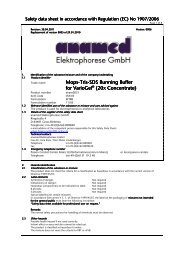Anarapid gel drying solution - anamed Elektrophorese Gele und ...
Anarapid gel drying solution - anamed Elektrophorese Gele und ...
Anarapid gel drying solution - anamed Elektrophorese Gele und ...
You also want an ePaper? Increase the reach of your titles
YUMPU automatically turns print PDFs into web optimized ePapers that Google loves.
Safety Safety data data sheet sheet in in accordance accordance accordance with with Regulation Regulation (EC) (EC) No No 1907/200 1907/2006 1907/200<br />
Page 6 of 9<br />
Trade name: AnaRapid Gel<strong>drying</strong> <strong>solution</strong><br />
Company/Undertaking: <strong>anamed</strong> <strong>Elektrophorese</strong> <strong>Elektrophorese</strong> GmbH<br />
Ringstraße Ringstraße 44,<br />
4 , DD-64<br />
D 64 6440<br />
401 40 1 Gross Gross-Bieber<br />
Gross<br />
Bieber Bieberau Bieber au<br />
Telephone: int+49 int+49-(0)61<br />
int+49<br />
(0)61 (0)6162<br />
62-809840<br />
62 809840 Revision: 30.04.2011<br />
Product number: anam0017<br />
11. 11.1.4 11.<br />
1.4 CMR CMR CMR CMR effects effects effects effects (carcinogenic<br />
(carcinogen<br />
(carcinogen<br />
(carcinogenic<br />
icity, icity,<br />
ity, ity, mutagenicity, mutagenicity, mutagenicity, mutagenicity, toxicity toxicity toxicity toxicity for for for for the the the the reproduction)<br />
reproduction)<br />
reproduction)<br />
reproduction)<br />
Carcinogenicity No data available.<br />
Mutagenicity No data available.<br />
Toxicity for the reproduction No data available.<br />
11. 11.1.5 11.<br />
1.5 Comprehensive Comprehensive Comprehensive Comprehensive evaluation evaluation evaluation evaluation of of of of the the the the CMR CMR CMR CMR properties properties properties properties of of of of substances substances substances substances subject subject subject subject to to to to registration<br />
registration<br />
registration<br />
registration<br />
No data available.<br />
11.1.6 11.1.6 Information Information Information Information on on on on likely likely likely likely routes routes routes routes of of of of exposure exposure exposure exposure<br />
Inhalation: causes a state of intoxication. When inhaled in larger quantities, the solvent vapours cause a narcotic effect.<br />
Skin contact: prolonged or repeated skin contact may cause removal of natural fat from the skin resulting in<br />
dermatitis (skin inflammation).<br />
Eye contact: irritant effect.<br />
Ingestion: nausea, heartburn, vomiting.<br />
11.1.7 11.1.7 Symptoms Symptoms Symptoms Symptoms related related related related to to to to the the the the physical, physical, physical, physical, chemical chemical chemical chemical and and and and toxicological toxicological toxicological toxicological characteristics<br />
characteristics<br />
characteristics<br />
characteristics<br />
After inhalation: headache, dizziness, inebriation, excitation, narcotic effect.<br />
After ingestion: inebriation, nausea, heartburn, vomiting.<br />
After contact with eyes: burning.<br />
11.1.8 11.1.8 Delayed Delayed Delayed Delayed and and and and immediate immediate immediate immediate effects effects effects effects as as as as well well well well as as as as chronic chronic chronic chronic effects effects effects effects from from from from short short short short and and and and long long----term long long term term term exposure exposure exposure exposure<br />
Prolonged or repeated skin contact may cause removal of natural fat from the skin resulting in dermatitis<br />
(skin inflammation).<br />
Chronic consumption of large amounts of ethanol leads to organ damage (especially liver damage) and to damage<br />
of the nervous system.<br />
11.1.9 11.1.9 Interactive Interactive Interactive Interactive efects efects efects efects<br />
No information on interactive effects available for the product.<br />
11. 11.1.10 11.<br />
1.10 1.10General General General General remarks remarks remarks remarks<br />
The product has not been tested. Labelling on the basis of physical properties (flash point).<br />
12. 12. 12. Ecological information<br />
12.1 12.1 TTTToxicity oxicity oxicity oxicity<br />
Aquatic Aquatic Aquatic toxicity toxicity: toxicity<br />
LC50 (fish) 8140 mg/l/48 h (Leuciscus idus; golden orfe)<br />
(ethanol)<br />
(IUCLID)<br />
> 1000 mg/l/96 h (Cyprinus carpio; carp)<br />
(polyethylene glycol 200)<br />
(OECD 203)<br />
EC50 (daphnia) 9268 - 14221 mg/l/48 h (Daphnia magna)<br />
(ethanol)<br />
(IUCLID)<br />
> 1000 mg/l/48 h (Daphnia magna)<br />
polyethylene glycol 200)<br />
(OECD 202)<br />
IC50 (algae) > 1000 mg/l/ 72 h (Desmodesmus subspicatus)<br />
(polyethylene glycol 200)<br />
(OECD 201)<br />
12. 12.2 12.<br />
Behaviour in sewage works:<br />
Treat by state-of-the-art technology before discharging into drains.<br />
Persistence Persistence Persistence Persistence and and and and degradability<br />
degradability<br />
degradability<br />
degradability<br />
Ethanol: biodegradation 94% (aqueous <strong>solution</strong>) (OECD 301 E). Readily biodegradable.<br />
12. 12.3 12.<br />
Bioaccumulative Bioaccumulative Bioaccumulative Bioaccumulative potential potential potential potential<br />
Partition coefficient n-octanol/water: - 0.3 (ethanol) (LOGKOW © databank) 4<br />
12.4 12.4<br />
No bioaccumulation is to be expected (log Pow


